Fitness and health pros: How Precision Nutrition coaches (and how you can coach this way too).
Here’s an inside look at how Precision Nutrition coaches clients, including our client-centric philosophy, habit-based methodology, and full client curriculum. I’ll even pull back the curtain on ProCoach, the program that’s allowing health and fitness pros around the world to coach the way we do.
++++
Today’s article is really exciting because I’m going to pull back the curtain and show you exactly (with, in some cases, screenshot-by-screenshot detail) how Precision Nutrition coaches clients.
I’ll also reveal how we mix world-class curriculum, elite-level coaching skills, and cutting-edge technology to get unprecedented client + business results.
Finally, I’ll share strategies that you can use immediately, in your own practice, to maximize client numbers and income while still maintaining control of your schedule and helping people get the best results.
Before digging in, however, I wanted to let you know that our industry-leading coaching platform — Precision Nutrition’s ProCoach — is opening soon.
Tested with over 100,000 clients, ProCoach makes it easy to deliver research-proven nutrition and lifestyle coaching to anyone who needs it… from paying clients, to family members, to co-workers, to loved ones.
It’ll help you grow your business while working less, getting better results, and living life on your own terms.
Want to coach in-person? Online? Or a combination of the two? Whatever fits your ideal lifestyle, it’s all possible with ProCoach.
To understand ProCoach you first need to understand why it was created, and the key problems it helps health and fitness professionals overcome.
JB shares his early coaching struggles and how PN went from 20 to over 100,000 clients with ProCoach.
Want to know exactly how ProCoach works? Then check this out.
See how other health and fitness pros are using ProCoach with their clients.
In summary, ProCoach delivers — to your clients, on your behalf — a total coaching solution, complete with daily lessons, habits, check-ins, and more.
Plus, as their coach, you’ll support them by answering questions, offering encouragement, and tracking progress through special ProCoach software.
The good news? On Wednesday, June 5th, we’ll be opening ProCoach to our Precision Nutrition Certification students and graduates around the world.
When you enroll, you’ll be able to use this ground-breaking software and curriculum in your business — with your clients — and easily, quickly, effectively deliver the habit-based coaching you learned in the PN Certification.
You see, everyone knows that habit-based coaching is more effective and has longer-lasting effects than typical diets or meal tracking. But not everyone knows how to do it effectively. We do, and today…
I’d like to show you how we coach. And how YOU can coach this way too.
In today’s article we’ll discuss how you can:
- Dramatically increase how many clients you can coach.
- Assess nutrition-coaching clients efficiently.
- Build a habit-based curriculum for each client.
- Deliver new habits, lessons, and assignments.
- Monitor consistency and adherence.
- Track physical, mental, and behavior changes.
- Provide accountability, mentorship, and support.
- Set clients up for long-term, sustainable success.
So let’s get started.
(By the way: This is a long post with a lot of detail. So please set aside some distraction-free time before digging in. Maybe even read it in two or three parts. You’ll be happy you did.)
Client-centered coaching: Shush your “inner expert”.
The history of fitness and health is littered with hard-ass authoritarian coaches.
Taking a page out of the military, these coaches deliver a series of no-pain, no-gain boot-camps where clients are given tough love and are taught to pay for their laziness and dietary transgressions with push-ups, cardio, and burpees.
This style of coaching features the coach as: Expert, Drill Sergeant, and Dictator. In this model it’s their job to tell clients what to do.
Sure, some coaches are at least polite about it. But, no matter how nicely they command, this approach remains coach-centered. It’s all about the coach and what they know. And it’s the opposite of client-centered.
Of course, as a great fitness / health coach, you probably are an expert. You have well-informed ideas and opinions on nutrition, movement, stress, and sleep. But…
There’s one thing you’re not an expert on:
Your clients’ lives.
Each client is actually the expert on their own bodies and their own lives. They live in their bodies and experiences 24/7. You don’t.
That’s a critical distinction. Because…
Your clients have their own abilities and reasons for change.
They have their own limits, beliefs, preferences, backstories, and motivations. Some of these will be so far outside your personal experience that you couldn’t possibly have “standard” advice for them.
But that’s okay. As a change-based, client-centered coach, all you have to do is slow down and…
Quiet your own “expert” voice.
Ask questions. Listen deeply to your clients’ stories. And build your coaching approach around what you hear.
In doing so, you’ll actually uncover your clients’ unique abilities, reasons, and motivations (which will often be very different from yours). These will become your secret weapons.
Now you can help clients identify their own individual limiting factors. And then — more excitingly…
You’ll be able to help them propose their own solutions to their own problems.
We believe what we hear ourselves say.
So if you help clients produce and describe their own solutions, they’ll feel empowered, and embrace the solutions without you having to nag or boss them around.
This is a foolproof recipe for sustainable, long-term change.
Of course, this isn’t about coddling or being too nice or acquiescing to client demands.
Rather, client-centered coaching is about collaborating with clients and creating action plans based on what they feel they can do, not what you think they should be doing.
Let’s explore this methodology a little more.
Clients change by doing and experiencing.
These days, there’s a lot of emphasis on setting goals (e.g. lose 20 pounds) and then following a program (e.g. a diet plan or workout DVD set) to achieve those goals.
How’s that working?
On the goals side of the equation, we’re taught to think about what we want to accomplish. Then we’re supposed to make the goal specific, measurable, attainable, etc.
What happens once we’ve done all that? When we’ve set the ultimate goal?
For most people, not much.
That’s because goals aren’t achieved through the mere act of setting them. And goals aren’t achieved through sheer force of will.
On the program side of the equation, we’re taught to seek out a “Do this, don’t do that” program, summon up our motivation, and then turn our lives into “achieve that goal at all costs” projects.
We’re to become single-minded, unthinking, obedient little goal-chasing machines.
As you’ve probably seen…
This goal-focused approach fails most of the time.
Particularly when competing priorities come up and we haven’t built the necessary skills to be flexible and adaptable.
Then, since we haven’t “met our goal”, we feel bad. We think we’ve failed. We get frustrated and ashamed.
We might even give up. Or put that goal on the back burner till next January 1st, when we vow to take a crack at it again.
Based on my experience, success actually follows a different process.
- First, you break down the things you want to do into specific skills.
- Next, you develop those skills through intentional daily actions.
The formula pretty much looks like this:
Practice daily to build skills.
Build skills to achieve goals.
Some people call this approach habit-based, others call it practice-based. They’re one and the same, and are based on current research around skill acquisition and change psychology.
Growth and development come through daily habits and supporting experiences.
Here’s an example of how this works:
Goal: Eat better consistently
Let’s say you want to lose weight. You know that to lose weight you’ll need to eat better consistently. So that’s your real goal: Eat better consistently.
But you don’t have all the skills to do it just yet. So you have to break it down into…
Skill: Hunger and appetite awareness
Which skills are required to eat better consistently? We’ve identified hunger / appetite awareness as the most important initial skill for making progress.
But that’s not quite a concrete thing you can do. So you have to break it down into…
Practices: Eat slowly, and stop eating when satisfied
We use two daily habits to build the skill of hunger and appetite awareness.
Habit 1: Eat slowly.
Habit 2: Eat until satisfied, not stuffed.
This takes a month — two weeks for clients to learn, practice, and repeat each of the two habits. At the end of a month, clients have two very important habits that they can now use for the rest of their lives. They’ve learned it by doing it.
Not surprisingly, clients usually lose weight during this time. Because, of course, they’re learning to eat a bit less and adjust their intake according to body signals.
Even better, they’ve built two new habits that they can use for the rest of their lives, no matter what else happens.

This approach is the perfect antidote to “program-thinking” in fitness and health.
Instead of a meal plan to follow, which is a very short-term (and limited) solution that never really addresses core problems, this approach is progressive and helps clients build transferable skills while stair-stepping their way to real change.
If you integrate this style of coaching with your clients:
- They’ll accomplish goals more quickly (with less effort).
- They’ll have an easier time maintaining results.
- They’ll be able to do it within the context of a real human life (with its distractions, complexities, and surprises).
Here are some practical ways we implement this in our own coaching program.
The habits of Precision Nutrition Coaching.
Precision Nutrition Coaching is a one-year program that uses a client-centered, habit-based approach to help clients lose fat, gain strength, and improve their health.
Here’s an outline of the habits we recommend in our women’s nutrition coaching program. (Keep in mind, this is just one example; since we’re client-centered, we tailor habits to clients’ needs, gender, goals, etc.).
| Weeks | Habit |
|---|---|
| 1-2 | Take a 5-minute action |
| 3-4 | Eat slowly |
| 5-6 | Stop eating at “80% full” |
| 7-8 | Eat lean protein with each meal |
| 9-10 | Eat at least five servings of colorful fruits / vegetables |
| 11-12 | Make smart carb choices |
| 13-14 | Eat healthy fats |
| 15-16 | Plan PN-friendly meals |
| 17-18 | Record what you eat |
| 19-20 | Create & use a sleep ritual |
| 21-22 | Drink only calorie-free beverages |
| 23 | Break week |
| 24-25 | Use a targeted recovery strategy |
| 26-27 | Eat whole foods only |
| 28-29 | A little more, a little better |
| 30-31 | Protein & colorful plants at each meal |
| 32-33 | Practice 80% full |
| 34-35 | Do a 5-minute mind-body scan |
| 36-37 | Take a fitness information vacation |
| 38-39 | 20 minutes of de-stressing |
| 40-41 | Create and practice your fitness mission |
| 42-43 | Choose your own adventure |
| 44-45 | Prepare for your final photo shoot |
| 46-47 | Celebrate your progress |
| 48-50 | Spread the love, pay it forward |
Some of these habits (like “Eat slowly” or “Eat healthy fats”) are more straightforward. Others (like “Celebrate your progress” or “Pay it forward”) might be more open-ended.
The order of these habits, of course, isn’t an accident.
This is a carefully planned, cumulative client development experience.
We start simply and concretely, with clear and specific early habits that help our clients build a foundation. Over time, as clients develop skills and independence, we give them more freedom and opportunities to explore and expand their horizons.
Each habit builds on the previous ones.
Clients are able to do habits more effectively because of the skills they’ve already built. Which makes them feel even more successful and empowered.
They might start out tentative or nervous, but by the time they get to the final habits, they’re rocking ‘n’ rolling.
Here’s how our nutrition coaching software works.
Every day, clients:
- Receive an email with what’s on deck for that day.

- Log in to a personal home page for more detail.
- Read a lesson (which supports the habit).
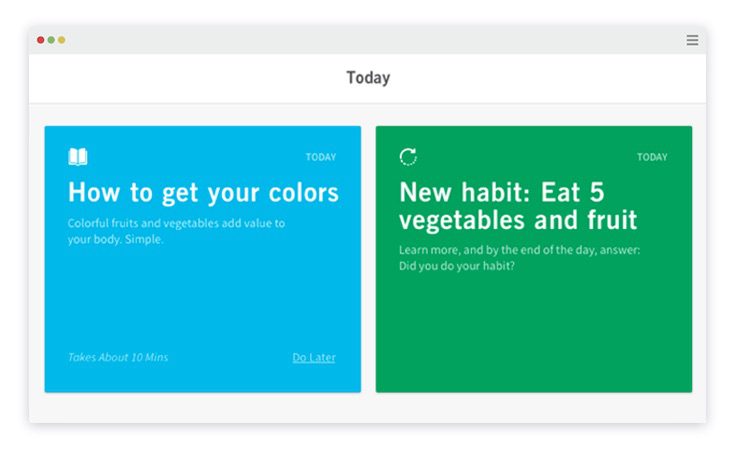
- Mark whether or not they’ve read their lesson for the day.
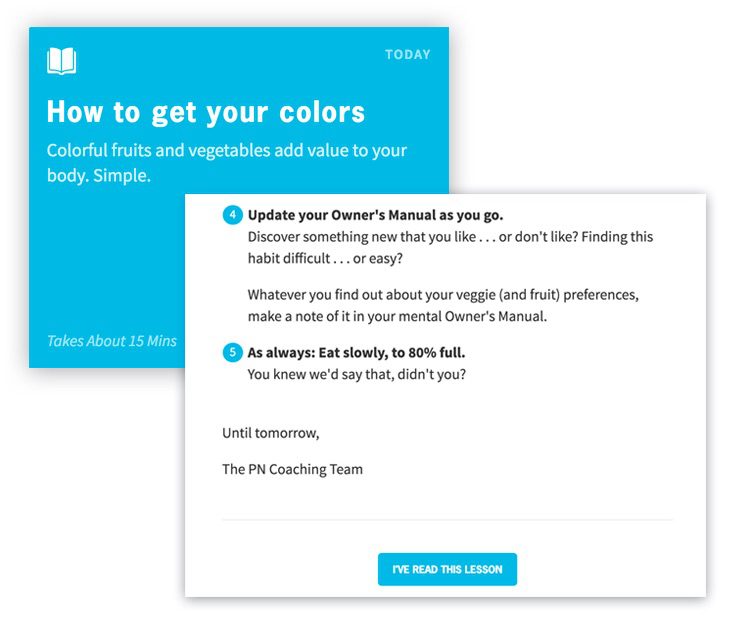
- Practice their habit for the day.
- Mark whether or not they’ve done their habit for the day.
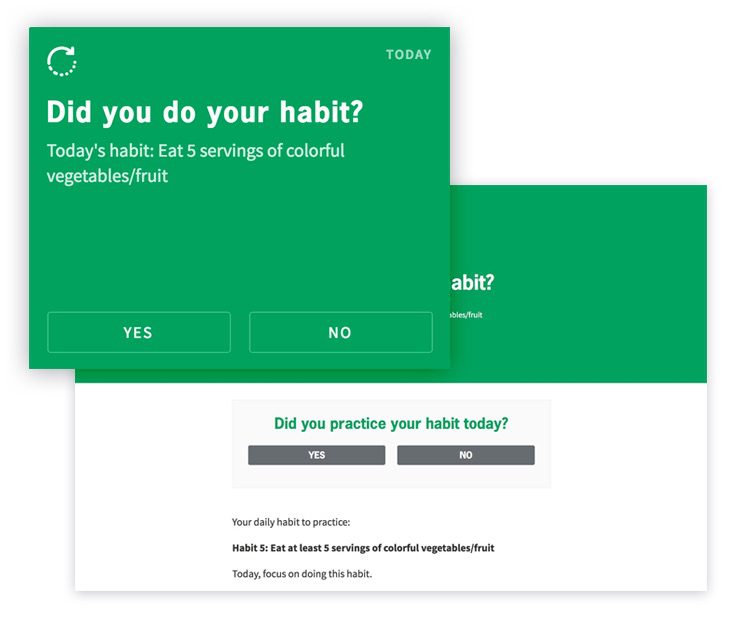
Then…
Every week:
- Clients measure and record their progress. This can be body measurements or other indicators (such as energy levels, mood, or habit consistency).

Every 2 weeks:
- Clients get a new habit to practice.
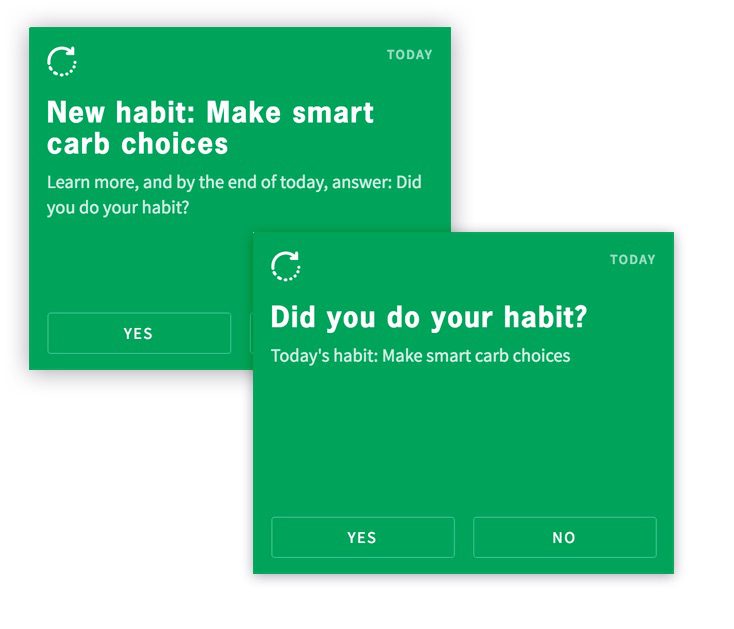
Every month:
- Clients upload more progress indicators such as photos, body measurements, etc.

How do we support clients’ new habits?
Habits are supported by lessons.
We ask clients to practice a new habit for 2 weeks. During this time we share short lessons and assignments that help them understand the habit more deeply and implement it within the context of their lives.
For example, here’s a list of the lessons we use with the habit “Eat at least five servings of colorful fruits and vegetables.”
Lesson 1: How to get your colors.
Lesson 2: Just add vegetables.
Lesson 3: How to prep and cook your vegetables.
Lesson 4: The waste-not game.
Lesson 5: Greens supplements and powdered veggies.
Lesson 6: Tomato travels.
Lesson 7: Who’s your farmer?
Lesson 8: What’s for breakfast?
Lesson 9: PN Coaching movie night.
Lesson 10: Are you over-processing your fitness?

Most habits offer Level 1 and Level 2 options.
Clients can make a habit as easy or as challenging as they like.
For newer clients, this takes away the fear of “doing it right” or “having to do too much”. Even the most intimidated beginner can usually find a habit level that works for them.
For more experienced clients, a bit of difficulty or a tougher game to play keeps them interested, challenged, and growing.
For example:
Level 1:
If you’re new to eating our plant friends, feel free to mix up veggies and colorful fruit. Keep it simple and just get in the habit of eating the rainbow.
Level 2:
If you’re already a produce-eating ninja, then use this habit to polish your plant consumption skills. Here are some things to try (choose one):
- Improve your overall consistency.
- Try more servings, especially of colorful vegetables.
- Try new vegetables.
- Try a new way of prepping or cooking familiar favorites.
- Aim for more dark leafy greens.
- Hit up the farmer’s market and try something in season or something organic.
We don’t just give our clients habits.
We build their skills.
Over the course of each program, we help clients build dozens of skills through very specific and well-defined daily habits.
Each habit is decided upon using our “Five S Formula”.
Simple.
The best habits are small daily actions that can be done in the context of real life.
If you ask yourself or your client, “On a scale of 0-10, how confident do you feel you could do this habit every day for the next 2 weeks?” the answer should be a 9 or 10. Anything lower and the habit is too challenging or intimidating.
Segmental.
Most goals are too big, or complicated, to try for in one go. Most skills are the same way.
So you break them down into defined and organized segments. Just like when learning / teaching complex exercises, you need to chunk bigger things into their component parts.
Sequential.
Once you have segments, you have to practice those segments in the right order.
If you do “thing 4” before “thing 1” you’re less likely to succeed. So start with thing 1, then do thing 2, then thing 3, and so on.
Do the right things in the right order and success is a reliable outcome.
Strategic.
Being strategic means being purposeful.
Strategic habits create a set of smart, deliberate decisions that leverage your strengths to help you address the thing that’s in your way right now.
Focus on that one thing — and only that thing — and a difficult process becomes easier and faster.
Supported.
Nothing worth doing can be done alone.
Habits work best when they’re supported by some form of teaching, coaching, mentorship, and accountability.
Habits are good.
A curriculum is even better.
The habit-based approach is awesome. However, if you — or your clients — have ever tried a habit-based program or app on its own, you probably got stuck with questions like:
- Which habits?
- In what order?
- How do I actually do the habits?
- What if this habit is too hard or easy for me?
- Why can’t I do four habits at once?
- And so on.
That’s why we focus on a habit-based curriculum.
A curriculum is a set of strategic, logical lessons and activities that go in a particular order, step by step.
It’s a purposeful program, plan, and progression based on the best practices of client learning, engagement, and development.

While the order of the habits above might seem a bit random, each one is carefully placed in a particular sequence based on very specific learning objectives.
To check out detailed curriculum guides, including a lesson-by-lesson breakdown:
Habits and lessons are cumulative and coherent.
Each habit / lesson builds the skills for future habits / lessons.
Then, later habits and lessons return to themes and ideas from earlier ones.
Everything is connected to everything else in a logical progression.
For instance:
Week 4:
The “Notice and name” lesson covers the importance and basic process of self-observation and self-awareness.

this leads to…
Week 14:
The “Experiment day: Snapshot” lesson, a very simple self-tracking exercise that looks at a few items throughout the day like energy levels, mental state, mood.
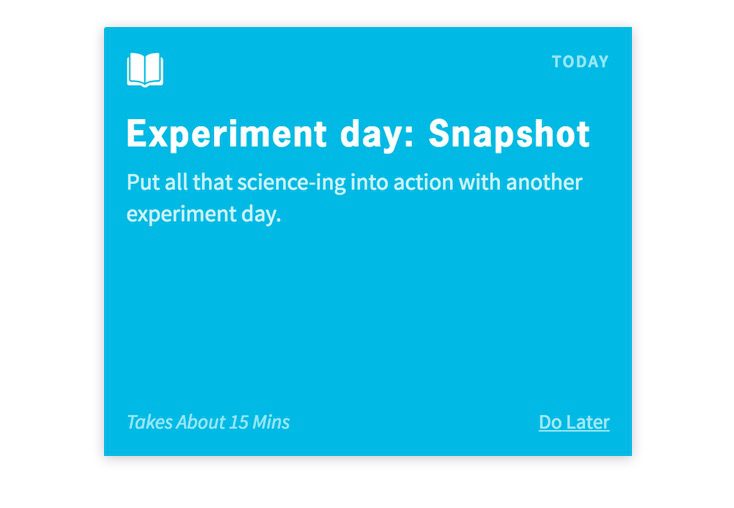
which leads to…
Week 17:
“Record your intake” habit

and eventually…
Week 29:
The “How to listen to your body” lesson, which helps clients analyze patterns in habits.

Week 35:
The “Your schedule doesn’t lie” lesson, which helps clients keep a time diary.

Week 38:
The “Time bandits, time warriors” lesson, which helps clients review time use and what it says about priorities.

And so on.
As you can see…
It all fits together. It’s progressive.
Just like any other subject, you start at the beginning.
When learning math, students learn what numbers are, then how to count them, then how to add and subtract them, and so on… before they can start doing calculus or algebra.
Notice also…
“Anchor habits” come first.
These are things you can do anytime, anywhere. They’re foundational behaviors.
For example, for fat loss, the two anchor habits are “eat slowly” and “eat to 80% full”. These trump all other habits.
When clients get stuck or overwhelmed with new habits, they can simply return to these “anchor habits”.
Concrete, practical, prescriptive habits come first.
“Do X in Y way” habits lead the way.
While clients can still customize all habits to their needs and nutritional levels, early habits focus on clear, unambiguous basics.
Then, we start loosening the reins, allowing more open-ended habits and interpretations of them.
For example:
- Early, concrete habit:
Eat 5 servings of colorful fruits and vegetables each day
- Somewhat open-ended habit midway through:
Use a targeted recovery strategy
- Completely open-ended habit near the end of the program:
Pay it forward

In addition, we like to mix things up. For example…
We mix up “hard” and “easy” habits.
Not all clients will struggle with the same habits. However, some habits tend to be harder than others.
We carefully dole out “hard” and “easy” habits so that clients aren’t constantly asked to do difficult things.
We also mix up “new stuff” and “review / consolidation” habits.
For example:
- Habit:
Eat whole foods only (a “stretch” habit, fairly difficult, requires learning new things) is followed by…
- Habit:
A little more, a little better (relaxing the control, scaling back expectations, allowing client to choose the next actions and simply improve slightly on what is familiar).

Some habits are “stretch habits” or “experiment habits”.
(Rather than “forever” habits.)
These are presented as “things to try” for 2 weeks, rather than “you should always do these as specified, forever”.
For example:
- Eat mostly whole foods.
- Drink only calorie-free beverages.
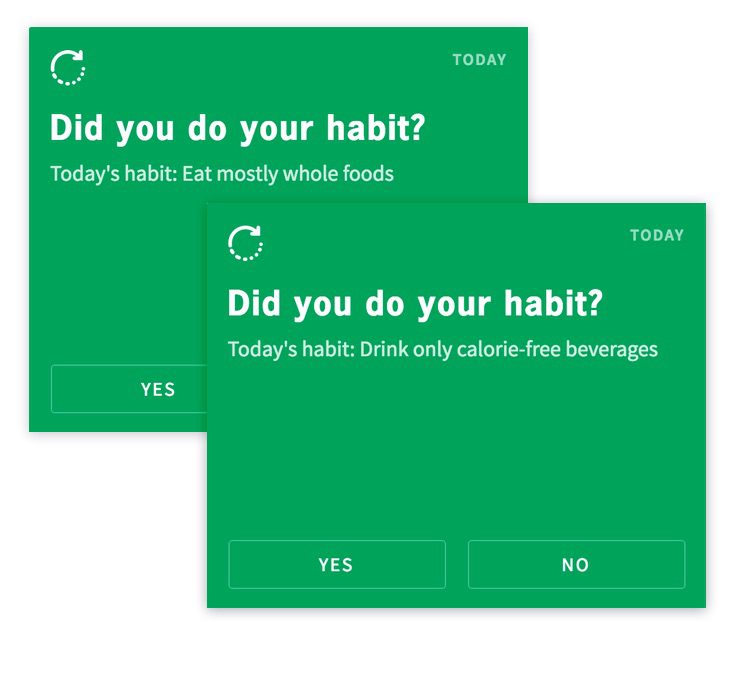
The idea here is for clients to:
- Try something that pushes their boundaries for 2 weeks.
- Expand their skills and repertoire while doing so.
- See what they learn and discover about themselves.
- See what they like, need, and/or want through this process of experimenting.
- Add this information and insight to their understanding of their needs.
At the end of the 2 week “play period”:
- Clients decide what was most interesting, valuable, and useful for them.
- They decide what pieces of that habit to keep.
Stretch habits in particular are great opportunities for coaching and collaboration.
- For Level 1 clients, stretch habits get them outside their comfort zone.
- For Level 2 clients, stretch habits encourage them to “up their game”, improve their execution and/or variety, and refine their skills.
A new kind of personal: Building your Owner’s Manual.
What’s interesting about this habit-based approach (supported by daily lessons and assignments) is that it’s personal in a unique way.
When most coaches think “personal”, they think about telling clients what to do based on something physiological.
For example:
- You weigh 180 pounds, so start eating xx grams of protein.
- You have xx genotype, so avoid xx foods.
- You just finished working out, so eat exactly xx.
And while there’s nothing wrong with suggestions based on known physiology, it’s still a coach-centered approach.
A client-centered approach recognizes all this physiological information while also taking into account what clients can reasonably do within the context of their lives.
We call this process “Building Your ‘Owner’s Manual”.

Throughout our coaching, we ask clients to track their progress, gather data, and reflect on thought exercises. The purpose of this is to write an “Owner’s Manual” — a collection of information and analysis about their lives, bodies, needs, wants, and real-life-tested experiences.
The Owner’s Manual:
- collects information about the client,
- asks the client to test hypotheses and collect data for making decisions,
- increases the client’s self-awareness and self-knowledge, and most importantly,
- puts the client in charge (which makes them take responsibility and reduces their resistance).
Each client creates their own Owner’s Manual by answering several sets of questions online throughout the course of the program. This process helps clients:
- Take responsibility for themselves — their thoughts, their beliefs, their stories, their environments, and most importantly, their behaviors. (No more coach-blaming or “This diet / workout plan didn’t work for me!”)
- Feel empowered by and invested in the idea that they now have a set of “handling instructions for their bodies”. (No more “one-size-fits all” programs.)
- Test hypotheses, gather data, and draw conclusions, just like scientists. (No more blindly “just following the rules”.)

This is a very different kind of personal.
A good Owner’s Manual empowers clients to make informed decisions about their own needs, wants, and priorities (instead of you telling them what to think or feel or do). It’s client-centered coaching at its best.
Of course, none of this eliminates the need for:
- Guidance and support.
- Strategies to get through blocks and setbacks.
- Problem solving and goal setting.
Indeed, that’s what what coaching is actually for.
Unfortunately, a lot of coaches spend too much time trying to measure adherence, trying to put together one-off education sessions, and doing a host of other tasks that should be automated.
This robs them of valuable time they could use to do what humans do best…
Build accountability, support, and relationships.
Automated lessons, habits, assignments, accountability checks, and progress checks are awesome. In fact, they’re the cornerstone of our very successful program, which produces results like these:
And these:
And these:
- Precision Nutrition Coaching – Men’s Hall of Fame
(225+ men’s before and after photos. Ages 21-70)
- Precision Nutrition Coaching – Women’s Hall of Fame
(375+ women’s before and after photos. Ages 21-74)
However, both research and experience show:
People do their best when they have strong, supportive relationships with a mentor or coach.
Having a ready-made curriculum (a clear, strategic, purpose-driven progression through client development and learning) frees coaches up to do the relationship-building, supporting, guiding, helping, and coaching that clients deserve.
Sure, if clients are ridiculously motivated and relentlessly tenacious, they might be able to figure everything out on their own without a coach or mentor.
Maybe.
However, most people need some amount of support. And that’s okay. It’s not a sign of weakness or incompetence. In fact, it’s the way most humans do most things.
The individual hero who accomplishes big things all by themselves is a myth.
That’s why, as a coach, it’s important to provide the following to your clients:
Encouragement during the courage phase.
The “courage phase” is the gap between when your clients commit to something and when they have the skill to actually do it.
At first, clients are committed but not capable. That’s scary and takes courage.
At times like this, it’s important to get enthusiastic support from coaches or mentors who’ve been through the process themselves.
A known cadence of accountability.
We all know accountability — regularly checking in with someone — is important. The social commitment helps us stick with what we started.
But accountability works best if it happens at regular, expected times. Whether through an app, in a group, or one-on-one, accountability should have a known cadence (i.e. weekly, every other week, etc).
Access to a respected coach.
Most people don’t want “a coach”. They want a leader, an expert, someone they trust and respect.
Most people don’t want someone in their face “coaching” them 24/7. They just want the security of knowing for sure that someone is there if they need them.
A positive progress focus.
Comparing clients to some superhero ideal doesn’t work. It makes them feel inadequate.
Which is why it’s important to seek out any and all positive progress. Bonus points for celebrating that progress when it happens.
Even if clients aren’t seeing physical results yet, if they’re showing up, good things are happening. By identifying and celebrating that, the physical progress will follow.
Proactive obstacle identification.
It’s not all high-fiving and progress celebration. Sometimes real challenges come up. People need strategies to move past these inevitable obstacles.
What’s better than solving the problem? Avoiding that problem in the first place.
Experienced coaches can give clients a heads-up about what they’re likely to come up against. That way clients know what problems to look out for, and they’re less likely to get derailed.
Help when stuck.
Even with the best daily habits, ongoing progress tracking, accountability, and proactive obstacle identification, sometimes clients get stuck.
That’s when an expert guide can help. Someone who’s “been there, done that” and knows how to navigate.
In our coaching programs, this is where our coaches really shine. They’re available to provide careful, patient, empathic coaching to clients as they go through the full journey.
But here’s the thing… this is only possible because we’ve automated so much.
The habits, lessons, assignments, consistency trackers, and progress reports are delivered reliably in a way that can scale. So coaches aren’t wasting time doing “admin” work.
Now they’re free to do what only a caring, empathic human coach can do: connect.

As a special bonus: Coaches can take on more clients this way, helping more people than they ever thought possible.
You see, when I started doing online nutrition coaching, I soon realized that I could only handle 25-50 clients at a time while preserving quality control. Most of my time was wasted on admin tasks.
However, with automation, Precision Nutrition now coaches about 5,000 amazing clients per year with 20 full-time Precision Nutrition supercoaches (and an awesome group of part-time interns and mentors). That’s an average of about 250 clients per coach.
It’s the best of both worlds: 10 times the clients with even better results because of our proven, progressive, and change-promoting curriculum.

Tracking, feedback, and oversight for coaches.
So far I’ve talked a lot about the client side of things. Let’s look at the coach experience.
How do our coaches onboard, monitor, and provide feedback to clients?
Over the last 15 years, we’ve spent millions of dollars building our coaching software and curriculum — Precision Nutrition’s ProCoach — with the help of world-class researchers and dozens of full-time ninja programmers.
ProCoach is designed to:
- Triage and assess new clients quickly and efficiently.
- Deliver habits, lessons, and assignments from our curriculum.
- Monitor consistency and habit adherence every single day.
- Track physical, mental, and behavior changes every week.
- Set clients up for long-term, sustainable success.
- Help you attract new prospects and clients with photos, data, testimonials, and straight-up, irrefutable, hard-data evidence of success.

 dashboard.
dashboard.We start by getting to know our clients.
When clients enroll, we ask them lots of questions about themselves. We want to know as much as possible so we can best help them.
- What do their lives look like?
- Who are they as people?
- What are their goals?
- What are their biggest challenges?
- How much do they know about nutrition right now?
- How much of that can they actually do?
- Do they have any injuries or other limitations?
- Etc.

Then we track our clients.
Not only do coaches get the confidence of knowing their clients are well taken care of, they can also see their progress through a special dashboard that allows them to track their entire client list at a glance.

The client list gives coaches overview stats on each client, including:
- where they are in the program,
- how consistent they’ve been, and
- how their body has changed.
But that’s just the beginning.
We keep learning about our clients as individuals.
Coaches can also drill down to each person’s client details by clicking on their name.

There, coaches see photos, important details about clients (from their intake questionnaire), and how they’re doing in the program. Coaches also get access to pretty much everything they’ve done (or not done) in the program to date.
We keep an eye on how clients are doing.
Once a coach’s client list gets longer, they keep close tabs on their communications with each individual with this real-time feed of messages and updates.
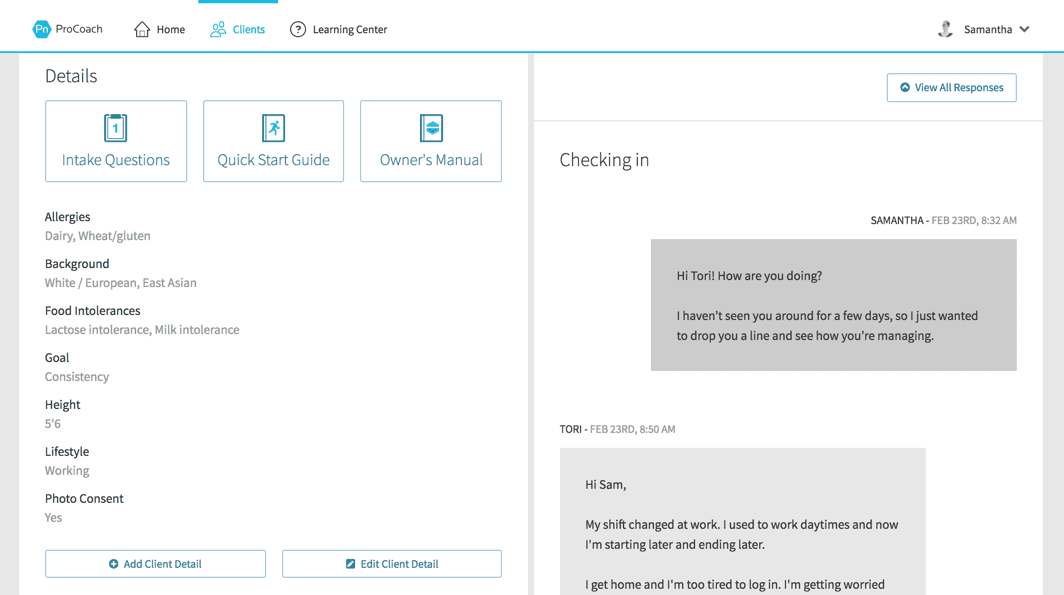
Each client’s “Progress” section records whether the client did their habit and completed their lesson for the day.

Responses to their assignments and lessons are also recorded in the “Archive” section.

Of course, coaches get access to these adherence and consistency data through the Client List and Client Details areas of the ProCoach dashboard, as well.
We help clients assess themselves.
Along with the lesson and habit completion information, the system collects such other assessments as:
Progress updates.
Every few weeks clients are asked to report body weight, girths, photos, and other progress indicators. Also included are questions about whether they felt like their behaviors for the last week or so matched up with their goals.

Surveys.
Every few months, clients are asked to fill out a quick survey. One is a psychological assessment evaluating their mindset and resiliency. Another asks important questions about how they feel about their progress so far. Another asks them to rate the program.
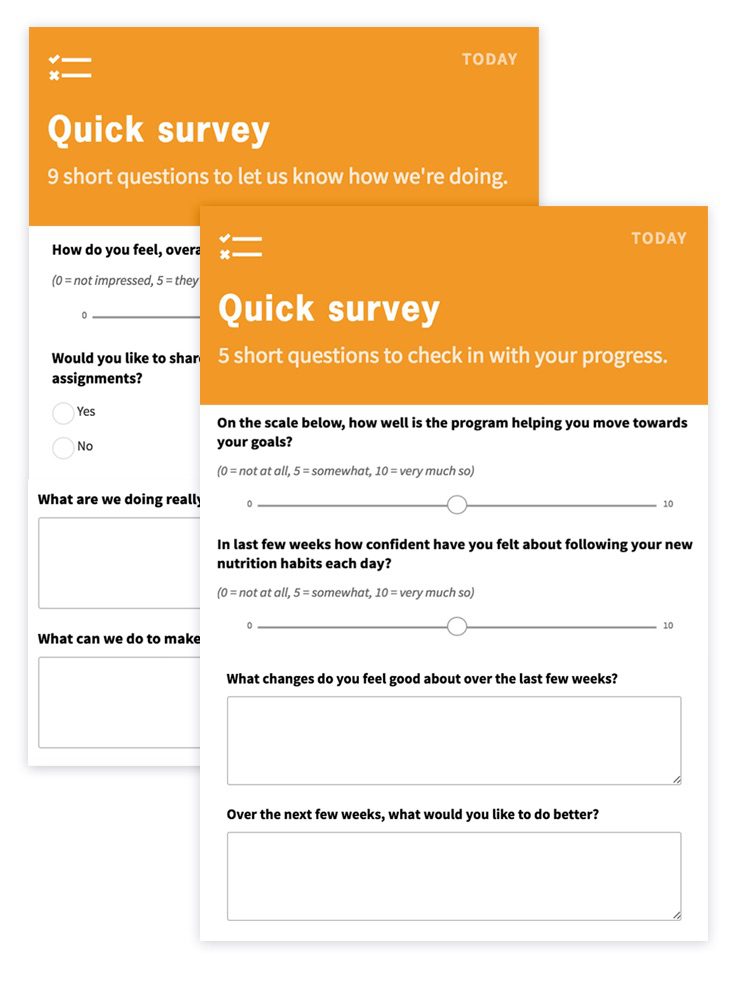
Coaches can easily access all of this within the ProCoach dashboard area.
We stay in touch.
Finally, there’s a built-in messaging system within the ProCoach software.
Through this system, clients can reach out to coaches and vice-versa. It’s like email but it’s all contained within the ProCoach software.
Imagine having all of your client’s details right there in front of you as you emailed them: their body stats, progress, latest messages and lesson responses, photos… everything.
Each time a coach is messaging with a client, all of that client’s data will be up on the screen at the same time. Coaches don’t have to rely on memory.
Everything coaches need to know is all right there for them, literally at their fingertips.

In addition to the messaging system, there’s a built-in feedback system. So, when a coach reviews a client’s progress updates or assignments, they can send feedback or encouragement that’ll be delivered to them via their coaching homepage.

15 years ago we set out to build a nutrition coaching platform and curriculum to deliver client-centered, habit-based coaching in a way that’s awesome for both clients and coaches.
Today, we now have efficient tracking, seamless oversight, and easy sharing of feedback.
By automating as much as possible, coaches can work with more clients, deliver better results, and spend less time on recordkeeping.
Help more clients with our software’s reliability, scaleability, and automation.
So far I’ve talked a lot about automating certain tasks so they’re done reliably and in a way that scales.
But what does that really mean?
Reliable
You’re able to deliver the same high-quality coaching experience to every client regardless of what else is going on… in your life or your clients’.
This is hard to do when your coaching is one-off or when you have more than one employee.
Scaleable
You’re able to coach 5 clients, 50 clients, or 500 clients.
(And going from 5 clients to 500 requires very little additional effort.)
We’ve used ProCoach to help over 100,000 clients over the past 15 years. So I think it’s safe to say that scalability is well-proven.
Automated
You’ll be able to deliver nutrition habits, lessons, and assignments on time and on track, no matter what else you’re doing.
Whether we’re sleeping, busy, out of town, in bed with the flu, stuck in traffic or on a plane somewhere above the Pacific ocean… it doesn’t matter.
Our system will take care of your clients regardless, and make sure they get what they need.
Daily, weekly, and monthly check-ins are completely automated too.
In the end, I think Precision Nutrition Coaching is so unique because it does what nothing else out there can do:
It uses high-powered technology (ProCoach) to automatically deliver a progressive and carefully curated curriculum (built right into ProCoach) that’s supported by live coaches.
Want help doing this yourself?
With this article, I tried to break down each component of Precision Nutrition Coaching to give you an inside look at exactly how we use all three elements:
- software,
- curriculum, and
- coaching.
Hopefully you now have a better understanding of how we coach as well as how you can use some of these elements in your own coaching.
If you’d like some support with this, we can help.
As I mentioned, Precision Nutrition’s ProCoach software has been specifically designed to help you use client-centered, habit-based coaching in your own business.
ProCoach will help your business.
- Add habit-based nutrition coaching to your existing services, easily.
- Add a totally new, and highly profitable, revenue stream, immediately.
- Market and sell your services to clients and prospects, effectively.
- Take on more clients, while offering high-quality coaching and attention.
ProCoach will help your clients.
- Assess new clients quickly and efficiently.
- Deliver habits, lessons, and assignments from our proven curriculum.
- Review every client’s consistency and habit adherence at any time.
- Track every client’s physical, mental, and behavior changes every week.
- Set clients up for long-term, sustainable success.
- Attract new clients with photos, data, testimonials, and straight-up, irrefutable, hard-data evidence of success.
Ready to build a thriving coaching practice?
Tested with over 100,000 clients now, Precision Nutrition’s ProCoach makes it easy to deliver the sustainable, research-proven nutrition and lifestyle coaching discussed in this article to anyone who needs it… from paying clients and patients, to family, to co-workers, to loved ones.
Want to coach in-person? Online? A combination of the two? Whatever fits your ideal lifestyle, it’s all possible with ProCoach.
With the ProCoach curriculum, coaching tools, and software, you’ll be able to turn what you learned in the Precision Nutrition Certification into a thriving practice, getting better results with dozens, even hundreds, of people while working less and living life on your own terms.
Interested? Add your name to the presale list. You’ll save 30% and secure your spot 24 hours before everyone else.
On Wednesday, June 5th, 2019, ProCoach becomes available to all Precision Nutrition Certification students and graduates.
If you’re interested and want to find out more, I’d encourage you to join our presale list. Being on the presale list gives you two special advantages.
- You’ll pay less than everyone else. At Precision Nutrition, we like to reward the most interested and motivated professionals, because they always make the best students and clients. Join the presale list and we’ll give you 30% off the monthly cost of Precision Nutrition’s ProCoach.
- You’re more likely to get a spot. Remember, last time we sold out within hours. But by joining the presale list you’ll get the opportunity to register 24 hours before everyone else, increasing your chances of getting in.
If you’re ready to help more people live their healthiest lives, grow your business, and worry less about time and money… ProCoach is your chance.
The post Fitness and health pros: How Precision Nutrition coaches (and how you can coach this way too). appeared first on Precision Nutrition.
Source: Health1
